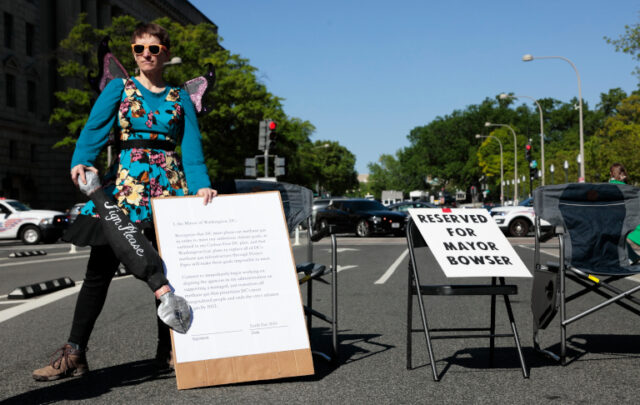NOTE: Images in this archived article have been removed.
Click on the headline (link) for the full text.
Here’s Why The Carbon Regulations EPA Will Announce Monday Are So Important
Jeff Spross, Climate Progress
On Monday, the Environmental Protection Agency
will release a first-ever set of regulations to cut carbon dioxide emissions from the country’s existing fleet of power plants. The agency recently
issued similar rules for new power plants, which will be finalized next year after a public comment period. The rules for existing plants will undergo a similar process.
But before
the political storm around the rules begins in earnest, here are the basic points everyone needs to know about why EPA’s carbon rules are so important.
It’s The First Step Towards A Global Solution
One of the points the Chamber of Commerce
made Wednesday in their premature analysis of the EPA regulations was that, by 2030, the cuts would only amount to 1.8 percent of the world’s annual carbon dioxide emissions. The point is technically accurate — climate change and the greenhouse gas emissions driving it are a global problem — but it assumes U.S. policy occurs in a weird sort of civilizational vacuum.
The
projections of future emissions the Chamber used are based on the assumption that business-as-usual continues and that various countries’ climate policies don’t change much. That, in turn, is an assumption about how countries will behave in the future. But as Obama
has made clear, half the point of the new regulations is to change the way other countries behave.
America may be the world’s second-biggest carbon emitter, but it remains by far the largest on a per-person basis. It’s also emitted more than any other country historically. And while China and India’s economies are huge, they’re spread over far larger populations than the U.S., and they’re still trying to lift hundreds of millions of their citizens out of very deep poverty. So Americans effectively emitted their way to our current prosperity. Furthermore, because we have so much more wealth per person,
we have far more economic room to cut carbon emissions and take risks on developing clean energy than China or India.

CREDIT: THE GREENHOUSE DEVELOPMENT RIGHTS FRAMEWORK
What this all means is that trust and goodwill between countries
is enormously important to building
a cooperative international response to climate change. Because of its position and prosperity, the United States can’t build that goodwill without taking the initiative to cut its own emissions: “It’s not [that] I’m ignorant of the fact that these emerging countries are going to be a bigger problem than us,”
Obama told the New Yorker a few months ago. “It’s because it’s very hard for me to get in that conversation if we’re making no effort.”
So when the next round
of global climate talks occurs in 2015, we’ll have a far better chance of actually locking down an international treaty to cut global emissions if the United States has already stepped up. Then we can bring other countries on board with their cuts, and then circle back around in a few years for an agreement to cut more. And suddenly that 1.8 percent isn’t a mere 1.8 percent anymore.
“American influence is always stronger when we lead by example,” Obama
said yesterday at West Point. “We cannot exempt ourselves from the rules that apply to everyone else.”
Climate Change Is A Threat To America And The World
Because carbon dioxide molecules absorb heat well, the more we dump into the atmosphere by burning fossil fuels, the more heat the atmosphere can absorb. This raises the overall temperature of the Earth as a system, in what’s called the “greenhouse effect” — carbon dioxide and other gases trap heat within the atmosphere, like the glass walls of a greenhouse trap heat within its interior. We can actually measure it: satellites
have tracked the heat imbalanceas the Earth absorbs more energy from the sun, while ice cores and other measurements
show a a long period of climate stability
going back thousands of years, followed by a sudden spike in carbon dioxide and global temperatures around the arrival of the fossil fuel-powered Industrial Revolution.

What does
all this mean for the Earth’s climate? Hotter average global temperatures mean more heat waves, more wildfires, and faster evaporation leading to more drought. But it also means more moisture in the atmosphere, so precipitation becomes heavier when it does come, and wetter areas become wetter while dry areas become drier. Sea levels rise from ice melt at the poles and cyclones become stronger from the oceans’ rising heat content, leading to more flooding and storm damage on the coasts. The poles heat up faster than the equator, destabilizing global weather patterns. Species and ecosystems collapse on both land and sea as climate change and ocean acidification alter their habitats. Crop production and food supplies are upended, fresh water becomes harder to come by, and vectors for pests and disease increase. Basically, rising global temperatures
shift the range of possible weather so that destructive and extreme events become more likely.
The scientific consensus is that global temperatures
can warm 2°C before those changes become truly catastrophic, though some research suggests even that threshold is too much. At humanity’s current rate of carbon dioxide emissions,
we’re set to blow past that limit and get somewhere near 5°C of warming by 2100. Simply put, that would bring a degree of climate change
far beyond anything that’s occurred the entire time human civilization has been on the planet. It might not even be possible, much less likely, for us to adapt to those circumstances.
U.S. Carbon Emissions Are A Sizable Part Of The Problem
At about 14.5 percent of 2012′s global emissions, the United States
is the world’s second-biggest producer of carbon dioxide, with China now in first and India in third. That same year, electricity generation
made up almost a third of the greenhouse gas emissions from America’s economy, with cars and other vehicles also making up close to a third, and industry emitting a fifth. The rest was filled in by commercial and residential buildings and agriculture, each for a tenth a pop.
EPA’s rules for new and existing power plants will address the electricity sector only, but the rest of President Obama’s
climate action plan aims to use the executive branch’s regulatory authority to cut emissions from those other sectors as well — by ratcheting up emission standards for cars, improving energy efficiency in homes and buildings, changing forestry and land-use practices, and plugging the various holes in our economy that release other greenhouse gases such as methane.
So while the carbon dioxide pumped out by America’s power plants is ultimately only a slice of the problem, the regulations to cut them down are the central pillar of the Obama Administration’s interlocking effort to reduce greenhouse gas emissions in every sector of the economy. And the political, social, and economic effort to sustain that central push will flow into all the other efforts as well.
Congress Isn’t Going To Do It Anytime Soon
It’s been well-documented by political scientists that
partisan polarization has increased significantly in the legislative branch over the last few decades, meaning both parties — but the Republicans especially — move more in ideological lockstep.

CREDIT: HTTP://VOTEVIEW.COM/
In 2009, when the Democrats still dominated Congress, that unity actually helped them pass bills like the stimulus, financial regulatory reform, and Obamacare. But policies to cut carbon emissions
are different. The benefits are spread across the entire population, and are still mostly to come in the future, while the costs will be here and now and fall the hardest on some specific and very influential groups — namely the fossil fuel industry. So when President Obama and the Democrats tried to push a cap-and-trade bill through Congress that year, moderate Democrats — especially in the coal-dependent states like West Virginia and Kentucky — felt enormous pressure to jump ship. And moderate Republicans were pressured by their own ideological cohort to
not jump on board.
As a result, cap-and-trade passed the House but went down to defeat in the Senate. Now that the Republicans have taken back the House, the situation is even worse for climate policy, and it will likely take several election cycles before another chance emerges for Congress to pass something. And we simply don’t have that much time. Global carbon emissions quite literally
need to peakwithin the next few years and then start falling fast if we want a good shot at staying below the 2°C threshold.
Fortunately, Congress has actually already handed the executive branch the tools to address this problem. Amendments to the Clean Air Act in 1990 require EPA to regulate emissions that threaten public welfare, and in 2007 the Supreme Court
ruled the agency could regulate carbon dioxide emissions if it found they posed such a threat. EPA
came to that exact conclusion in 2009, citing the rising seas, stronger storms, heavier floods, more intense heat waves, disrupted food supplies, shrinking fresh water supplies, and increased vectors for disease climate change would bring. By carrying through with the new regulations, the Obama Administration and EPA are in fact carrying out the will of Congress — just not the will of
this particular batch of congress members.
(30 May 2014)
A guide to Obama’s new rules to cut carbon emissions from power plants
Brad Plumer, Vox
On Monday, the Obama administration announced its most sweeping policy yet to address global warming — a proposed rule to cut carbon-dioxide emissions from the nation’s power plants as much as 30 percent below 2005 levels by 2030.
How can Obama do this without Congress? He’ll be working through the Environmental Protection Agency, which already has the legal authority to regulate US greenhouse gases…
Give me the basics. What is the EPA doing?
On June 2, the EPA proposed a new rule to regulate carbon-dioxide emissions from the nation’s existing coal- and gas-fired power plants — the first-ever rule of its kind.
For now, this is only a proposal. The EPA will spend the next 120 days gathering comments from electric utilities, environmentalists, and anyone else who cares to weigh in. It will then work on a final regulation that takes effect in June 2015. States will then have until June 2016 to draw up plans to implement the rule.
The EPA will set different emissions targets for each state — which, when taken together, will aim to cut carbon-dioxide emissions from the nation’s power sector as much as 30 percent below 2005 levels by 2030.
Electric utilities in each state will be given a variety of options for cutting their emissions — using more efficient technology, boosting their use of solar or wind or nuclear power, or even joining regional cap-and-trade systems that require companies to pay to emit carbon-dioxide.
There’s a lot at stake here. Coal and natural gas plants were responsible for about 38 percent of all US carbon-dioxide emissions in 2012:
Sources of US carbon dioxide emissions 2012

Center for Climate and Energy Solutions
So, if you like, this is equivalent to a roughly 6 percent cut in overall US emissions. (Or about 1 percent of global emissions.)…
(1 June 2014)
EPA unveils far-reaching climate plan targeting power plants
Evan Halper, LA Times
The Obama administration Monday morning unveiled its far-reaching proposal to curb climate change by substantially restricting emissions at power plants, a plan that promises to set off intense debate across the country amid the president’s boldest action yet to reshape the energy landscape.
Under the proposal, the administration is seeking to reduce greenhouse gases by 30% from their 2005 level by the year 2030. The plan gives local officials wide leeway in how to go about meeting that goal but it represents a major challenge for many of the states that remain heavily dependent on coal; some are already girding to fight the president on the proposed new rules.
The Environmental Protection Agency’s rollout of the 645-page plan launches a yearlong period of comment and review. The 2005 baseline year chosen by the administration reflects a time when emissions of greenhouse gases were at a peak. They have been reduced by about 10% since then, largely because many power companies have shifted toward cleaner-burning natural gas amid its recent boom. Meeting the EPA goal would require a further 17% reduction nationwide.
“This goal is achievable because innovations in the production, distribution and use of electricity are already making the power sector more efficient and sustainable while maintaining an affordable, reliable and diverse energy mix,” the preamble to the EPA plan states.
Still, many lawmakers and major business groups warn such a mandate would cause irreparable damage to the economy. The U.S. Chamber of Commerce, a staunch opponent of many initiatives to curb climate change, projects that the rule would cost the economy $50 billion annually, but the EPA concluded differently.
“The EPA projects that, in 2030, the significant reductions in the harmful carbon pollution and in other air pollution, to which this rule would lead, would result in net climate and health benefits of $48 billion to $82 billion,” the agency proposal says. “At the same time, coal and natural gas would remain the two leading sources of electricity generation in the U.S., with each providing more than 30 percent of the projected generation.”…
(2 June 2014)
Obama’s New Plan To Fight Climate Change Is A Really Big Deal
Tim McDonnell, Mother Jones
Update [Sunday, June 1, 6:30pm ET]: The Wall Street Journal is reporting that on Monday the EPA will announce sweeping new limits on carbon dioxide pollution from the nation’s existing power plants. The plan is said to require a nationwide reduction in carbon emissions by an average of 30 percent over 2005 levels by 2030, with different specific targets for each state. The rules, which will have a one-year public review period before becoming final, could represent one of the biggest actions taken by the US government to slow climate change.
***
On Monday, President Obama is set to unveil details of the cornerstone of his climate plan: Limits on carbon dioxide emissions from the nation’s fleet of existing power plants. The rules are likely to be the biggest step toward the president’s goal of cutting US greenhouse gas emissions 17 percent by 2020. The rules are already taking heat from the fossil fuel industry and Republicans in Congress, despite having the support of a majority of Americans. So what’s all the hullabaloo about, exactly? Here’s what you need to know…
(30 May 2014)
Coal power plant teaser image via shutterstock. Reproduced at Resilience.org with permission.


 What does all this mean for the Earth’s climate? Hotter average global temperatures mean more heat waves, more wildfires, and faster evaporation leading to more drought. But it also means more moisture in the atmosphere, so precipitation becomes heavier when it does come, and wetter areas become wetter while dry areas become drier. Sea levels rise from ice melt at the poles and cyclones become stronger from the oceans’ rising heat content, leading to more flooding and storm damage on the coasts. The poles heat up faster than the equator, destabilizing global weather patterns. Species and ecosystems collapse on both land and sea as climate change and ocean acidification alter their habitats. Crop production and food supplies are upended, fresh water becomes harder to come by, and vectors for pests and disease increase. Basically, rising global temperatures shift the range of possible weather so that destructive and extreme events become more likely.
What does all this mean for the Earth’s climate? Hotter average global temperatures mean more heat waves, more wildfires, and faster evaporation leading to more drought. But it also means more moisture in the atmosphere, so precipitation becomes heavier when it does come, and wetter areas become wetter while dry areas become drier. Sea levels rise from ice melt at the poles and cyclones become stronger from the oceans’ rising heat content, leading to more flooding and storm damage on the coasts. The poles heat up faster than the equator, destabilizing global weather patterns. Species and ecosystems collapse on both land and sea as climate change and ocean acidification alter their habitats. Crop production and food supplies are upended, fresh water becomes harder to come by, and vectors for pests and disease increase. Basically, rising global temperatures shift the range of possible weather so that destructive and extreme events become more likely.







